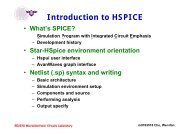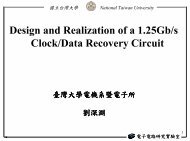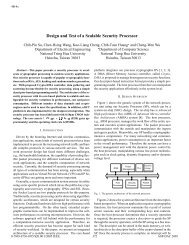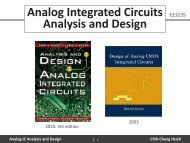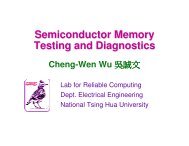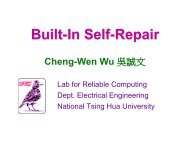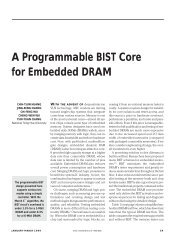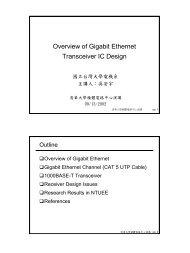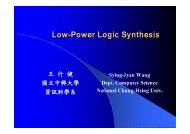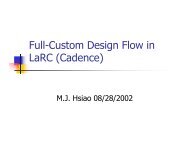A robust feedforward compensation scheme for multistage ...
A robust feedforward compensation scheme for multistage ...
A robust feedforward compensation scheme for multistage ...
You also want an ePaper? Increase the reach of your titles
YUMPU automatically turns print PDFs into web optimized ePapers that Google loves.
THANDRI AND SILVA-MARTÍNEZ: ROBUST FEEDFORWARD COMPENSATION SCHEME FOR MULTISTAGE OTAS WITH NO MILLER CAPACITORS 243<br />
transfer functions are around 6 and 10 dB at low frequencies,<br />
respectively. Post-layout simulation and experimental results<br />
<strong>for</strong> the single-ended amplifier using integrating and feedback<br />
capacitors of 5 pF are compared in Table II.<br />
CONCLUSION<br />
A <strong>compensation</strong> <strong>scheme</strong> <strong>for</strong> <strong>multistage</strong> amplifiers with no<br />
Miller capacitors was proposed. This <strong>scheme</strong> uses positive<br />
phase shift of LHP zeros created by the <strong>feed<strong>for</strong>ward</strong> path<br />
to cancel the negative phase shift of the poles (closed-loop<br />
dominant pole). A single-ended amplifier using the proposed<br />
NCFF <strong>compensation</strong> <strong>scheme</strong> was designed and fabricated in<br />
AMI 0.5- m technology. The amplifier combines high gain,<br />
high gain bandwidth, and good phase margin. Pulse response<br />
shows that the phase margin is better than 45 <strong>for</strong> capacitors in<br />
the range of 0.25–10 pF. The effect of pole–zero mismatch on<br />
the amplifier per<strong>for</strong>mance was studied and it was shown that<br />
the pole–zero cancellation should occur at high frequencies<br />
<strong>for</strong> best settling-time per<strong>for</strong>mance. Experimental results of the<br />
OTA show fast settling time and good stability.<br />
[11] M. Schlarmann, E. Lee, and R. Geiger, “A new multipath amplifier design<br />
technique <strong>for</strong> enhancing gain and bandwidth,” in Proc. IEEE Int.<br />
Symp. Circuits and Systems, vol. II, June 1999, pp. 610–615.<br />
[12] A. Thomsen, “A five-stage chopper stabilized instrumentation amplifier<br />
using <strong>feed<strong>for</strong>ward</strong> <strong>compensation</strong>,” in Proc. Symp. VLSI Circuits, Honolulu,<br />
HI, June 1998, pp. 220–223.<br />
Bharath Kumar Thandri received the B.E. (Hons)<br />
degree in computer science from Birla Institute of<br />
Technology and Science, Pilani, India, in 1998 and<br />
the M.S. degree in electrical engineering from Texas<br />
A&M University, College Station, in 2001.<br />
From 1998 to 1999, he worked in the DSP group of<br />
Texas Instruments (India) Ltd., Bangalore, where he<br />
developed software simulators <strong>for</strong> TI’s C6X range of<br />
DSPs. He was an Intern in the Computer Peripherals<br />
and Control Products Group of Texas Instruments,<br />
Dallas, TX, in the fall of 2000. Since November 2001,<br />
he has been with Cypress Semiconductors, Austin, TX, where he is working<br />
on the design of optical communication transceiver ICs and mixed-signal CAD<br />
flow development. His main research interests are in the area of high-per<strong>for</strong>mance<br />
and high-frequency analog circuits <strong>for</strong> communication and signal-processing<br />
ICs.<br />
REFERENCES<br />
[1] K. Bult and G. J. G. M. Geelen, “A fast-settling CMOS OpAmp <strong>for</strong> SC<br />
circuits with 90-dB dc gain,” IEEE J. Solid-State Circuits, vol. 25, pp.<br />
1379–1384, Dec. 1990.<br />
[2] R. Eschauzier and J. H. Huijsing, Frequency Compensation Techniques<br />
<strong>for</strong> Low-Power Operational Amplifiers. Boston, MA: Kluwer, 1995.<br />
[3] K. N. Leung, P. K. T. Mok, W. H. Ki, and J. K. O. Sin, “Three-stage<br />
large capacitive load amplifier with damping-factor-control frequency<br />
<strong>compensation</strong>,” IEEE J. Solid-State Circuits, vol. 35, pp. 221–230, Feb.<br />
2000.<br />
[4] F. You, S. H. K. Embabi, and E. Sanchez-Sinencio, “A <strong>multistage</strong> amplifier<br />
topology with nested Gm–C <strong>compensation</strong> <strong>for</strong> low-voltage application,”<br />
IEEE J. Solid-State Circuits, vol. 32, pp. 2000–2011, Dec.<br />
1997.<br />
[5] R. Eschauzier, L. P. T. Kerklaan, and J. H. Huijsing, “A 100-Mhz 100-dB<br />
operational amplifier with multipath nested Miller <strong>compensation</strong> structure,”<br />
IEEE J. Solid-State Circuits, vol. 27, pp. 1709–1717, Dec. 1992.<br />
[6] R. Eschauzier, R. Hogervorst, and J. H. Huijsing, “A programmable<br />
1.5-V CMOS class-AB operational amplifier with hybrid nested Miller<br />
<strong>compensation</strong> <strong>for</strong> 120-dB gain and 6-MHz UGF,” IEEE J. Solid-State<br />
Circuits, vol. 29, pp. 1497–1504, Dec. 1994.<br />
[7] H. T. Ng, R. M. Ziazadeh, and D. J. Allstot, “A <strong>multistage</strong> amplifier<br />
technique with embedded frequency <strong>compensation</strong>,” IEEE J. Solid-State<br />
Circuits, vol. 34, pp. 339–347, Mar. 1999.<br />
[8] Y. B. Kamath, R. G. Meyer, and P. R. Gray, “Relationship between frequency<br />
response and settling time of operational amplifiers,” IEEE J.<br />
Solid-State Circuits, vol. 9, pp. 347–352, Dec. 1974.<br />
[9] H. C. Yan and D. J. Allstot, “Considerations <strong>for</strong> fast settling operational<br />
amplifiers,” IEEE Trans. Circuits Syst. II, vol. 37, pp. 326–334, Mar.<br />
1990.<br />
[10] U. Chilakapati and T. Fiez, “Settling time design considerations <strong>for</strong> SC<br />
integrators,” IEEE Trans. Circuits Syst. II, vol. 46, pp. 810–816, June<br />
1999.<br />
José Silva-Martínez (SM’98) was born in<br />
Tecamachalco, Puebla, México. He received the<br />
B.S. degree in electronics from the Universidad<br />
Autónoma de Puebla in 1979, the M.Sc. degree<br />
from the Instituto Nacional de Astrofísica Optica y<br />
Electrónica (INAOE), Puebla, in 1981, and the Ph.D.<br />
degree from the Katholieke Univesiteit Leuven,<br />
Leuven, Belgium, in 1992.<br />
From 1981 to 1983, he was with the Department<br />
of Electrical Engineering, INAOE, where he was<br />
involved with switched-capacitor circuit design.<br />
In 1983, he joined the Department of Electrical Engineering, Universidad<br />
Autónoma de Puebla, where he remained until 1993. He was a cofounder of<br />
the graduate program on opto-electronics in 1992. From 1985 to 1986, he was<br />
a Visiting Scholar in the Department of Electrical Engineering, Texas A&M<br />
University, College Station. In 1993, he rejoined the Department of Electrical<br />
Engineering, INAOE, and from May 1995 to December 1998, was the Head<br />
of the Electronics Department. He was a cofounder of the Ph.D. program on<br />
electronics in 1993. He is currently with the Analog and Mixed Signal Center,<br />
Department of Electrical Engineering, Texas A&M University, where he is<br />
an Associate Professor. He is the inaugural holder of the TI Professorship I<br />
in Analog Engineering, Texas A&M University. His current field of research<br />
is in the design and fabrication of integrated circuits <strong>for</strong> communication and<br />
biomedical application.<br />
Dr. Silva-Martínez has served as IEEE Circuits and Systems Vice President<br />
Region 9 (1997–1998), and as Associate Editor <strong>for</strong> IEEE TRANSACTIONS ON<br />
CIRCUITS AND SYSTEMS PART II from 1997 to 1998 and May 2002 until the<br />
present. He was the main organizer of the 1998 and 1999 International IEEE<br />
Circuits and Systems Tour in region 9, and Chairman of the International Workshop<br />
on Mixed-Mode IC Design and Applications (1997–1999). He was a corecipient<br />
of the 1990 European Solid-State Circuits Conference Best Paper Award.



